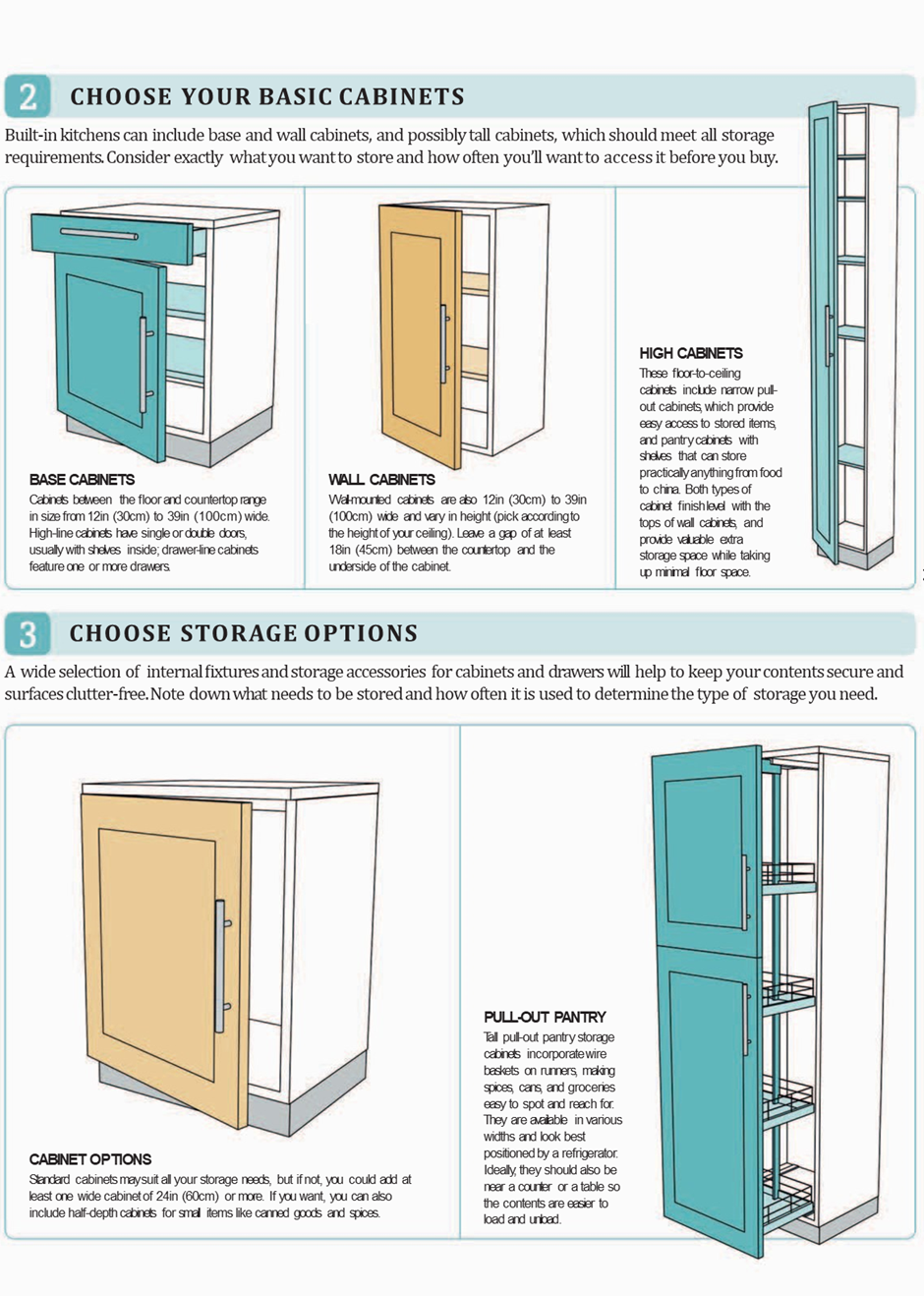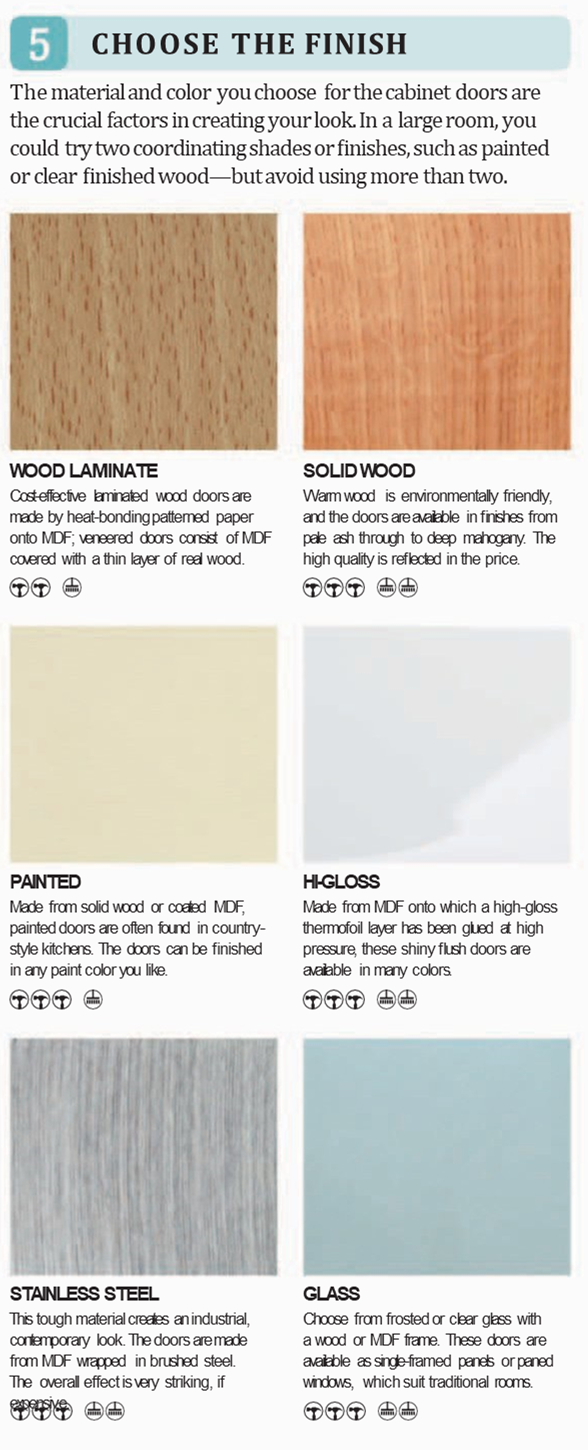Choosing your kitchen cabinets requires careful planning so that you get the right configuration to suit your needs perfectly. Start by asking yourself whether you prefer built-in or freestanding cabinets, and then consider individual elements—what storage do you need, and what finish do you want for the doors?
BUILT-IN OR FREESTANDING
Two factors will influence your choice: the look, and your
budget. Built-in kitchens are streamlined and use space effectively, but freestanding kitchens can be a cheaper option,
with lower installation costs, so you may be able to afford a better-quality
kitchen
BUILT-IN
Built-in kitchens where runs of cabinets are installed along the wall maximize storage and use
space efficiently, so they are practical
for all room sizes. Buy the cabinets
separately and hire a trusted contractor to install them, or opt for a specialized company that
will take care of everything from design
through to installation.
FREESTANDING
Freestanding kitchens can comprise separate
stand-alone cabinets, drawers, islands,
and other cabinets. They are flexible since you can add to them or rearrange the layout and even take them with you if you move. Freestanding cabinets
work best in larger kitchens since they don’t use space as efficiently as built-in
versions.
CHOOSE YOUR BASIC CABINETS
Built-in kitchens can include
base and wall cabinets, and possibly tall cabinets, which should meet all
storage requirements. Consider exactly
what you want to store and how often you’ll want to access it before you buy.
BASE
CABINETS
Cabinets between the floor and
countertop range in size from 12in
(30cm) to 39in (100cm) wide. High-line
cabinets have single or double doors,
usually with shelves inside; drawer-line cabinets feature one or more drawers.
WALL
CABINETS
Wall-mounted cabinets are also
12in (30cm) to 39in (100cm) wide and
vary in height (pick according to the
height of your ceiling). Leave a gap of at least 18in (45cm) between the
countertop and the underside of the
cabinet.
HIGH CABINETS
These floor-to-ceiling cabinets include narrow pull-out cabinets, which provide easy access to stored items, and pantry cabinets with shelves that can store practically anything from food to china. Both types of cabinets finish level with the tops of wall cabinets, and provide valuable extra storage space while taking up minimal floor space.
CHOOSE STORAGE OPTIONS
A wide selection of internal
fixtures and storage accessories for cabinets and drawers will help to keep your
contents secure and surfaces
clutter-free. Note down what needs to be stored and how often it is used to
determine the type of storage you need.
CABINET
OPTIONS
Standard cabinets may suit all
your storage needs, but if not, you could add at least one wide cabinet of 24in (60cm) or
more. If you want, you can also include half-depth cabinets for small items like canned goods and spices.
PULL-OUT PANTRY
Tall pull-out pantry
storage cabinets incorporate wire baskets on runners, making spices, cans, and groceries easy to spot and reach for. They are available in various widths and look best positioned by a refrigerator. Ideally, they should also be near a counter or a table so the contents are easier to load and unload.
CAROUSEL
A carousel helps you utilize
corner space that would otherwise be difficult to access. They are available as rectangular units with
semicircular shelves (shown above) or
L-shaped units with three-quarter-circular shelves that spin all the way
around.
PULL-OUT
CORNER UNIT
Another great way of making
use of otherwise restricted corner space, is these units have shelves mounted on a hinged arm. With
the door open, the shelves will swing out, giving you easy access to the entire contents.
DRAWERS
In the traditional method of
kitchen storage, drawers can be used for anything from cutlery and dish towels to fine china. Drawer
units are best located low enough so that you can see into the drawers when they are opened.
EXTRA-DEEP DRAWERS
Fashionable in contemporary
kitchens, these oversized drawers are deep enough to hold stacked-up dinnerware, saucepans, and
electrical appliances. Opt for a soft-close mechanism, which ensures that the drawers close gently and quietly
to minimize any accidents or noise.
DRAWER DIVIDERS
Wood or plastic inserts, which separate and secure various
items in drawers, include cutlery and
utensil trays, knife blocks, and plate holders—vertical pegs that prevent stacks of plates from being disturbed
when the drawer is moved.
PULL-OUT BASKETS
Keep your recycling organized and out of sight with baskets
that slide out on runners, concealed
behind doors or drawer fronts. Make sure the number of compartments is appropriate for the recycling
program in your area.
PLATE RACK
The benefit of a plate rack is that it keeps plates
separated and upright so they are less
likely to gather dust. It is a practical buy if you have expensive dinnerware
that you want on show and that you would
rather not stack. Often built into a wall unit,
a plate rack can be an insert for deep drawers.
WINE RACK
A wine rack allows bottles of wine to rest lying down.
Available in varying sizes, this feature
can be installed inside wall or base cabinets, as a pull-out from a
cupboard door, or installed as a
separate unit, often as an infill between two wider cabinets.
CHOOSE DOORS
The appearance and style of a kitchen depend very
much on the style of the cabinet doors.
Manufacturers offer a choice of solid
doors, which can be panelled or flush, or glass-panelled doors with various types of surround.
SOLID
Flat, flush doors are sleek,
contemporary, and easy to keep clean. Panelled doors consist of a sunken panel surrounded by a frame. Shaker-style
doors suit all types of kitchens, and
tongue-and-groove and arched panels are ideal for traditional design schemes.
GLASS PANEL
Glass-panelled doors are often
used alongside solid doors in wall units to provide contrast. Frosted glass is popular but go
for clear glass if you want to display the items inside. The cabinets may also be lit from within, providing a
gentle glow that illuminates the
contents.
CHOOSE THE FINISH
The material and colour you
choose for the cabinet doors are the
crucial factors in creating your look. In a large room, you could try two coordinating shades or finishes,
such as painted or clear finished
wood—but avoid using more than two.
WOOD LAMINATE
Cost-effective laminated wood
doors are made by heat-bonding patterned
paper onto MDF; veneered doors consist
of MDF covered with a thin layer of real
wood.
SOLID WOOD
Warm wood is environmentally
friendly, and the doors are available in
finishes from pale ash through to deep
mahogany. The high quality is reflected
in the price.
PAINTED
Made from solid wood or coated
MDF, painted doors are often found in country-style kitchens. The doors can
be finished in any paint colour you like.
HI-GLOSS
Made from MDF onto which a
high-gloss thermofoil layer has been
glued at high pressure, these shiny flush
doors are available in many colours.
STAINLESS STEEL
This tough material creates an
industrial, contemporary look. The doors
are made from MDF wrapped in brushed
steel. The overall effect is very
striking, if expensive.
GLASS
Choose from frosted or clear
glass with a wood or MDF frame. These
doors are available as single-framed panels or paned windows, which suit traditional rooms.
CHOOSE HARDWARE
Stylish hardware can make all
the difference, transforming an ordinary kitchen into something special, or
helping to create a particular effect.
Use identical hardware throughout for a streamlined effect and to keep the
scheme from looking messy.
BAR PULL
Bar pulls are angular in shape
and are available in various lengths and finishes. Opt for a sleek, minimalist finish if you have
a contemporary kitchen, or pick more
intricate designs if you have chosen a classic scheme.
D AND BOW
D pulls are simple and
stylish, with a softer look than bar pulls due to their curved corners. Bow pulls are similar, but consist
of a single, sweeping curve. Both of these styles are available in various lengths, thicknesses, and profiles.
DROP PULLS
Drop-pendant, drop-bar, and
drop-ring pulls are used almost exclusively in traditional kitchens and are hinged, unlike other types of pull. Simply
lift them up and pull them to open drawers
and cabinets.
RECESSED PULLS
Also known as integrated
pulls, recessed pulls create a flush, streamlined effect and are a trademark of an ultramodern kitchen.
They are usually positioned at the tops of drawers and cabinets and include moulded grooves and metal-inset
pulls.
CUP PULLS
These traditional metal pulls
are typically found on drawers rather than cabinets. Available in brushed nickel, chrome, or
antique brass, they often feature in Shaker-style kitchens, where they add a stylish finishing touch.
KNOBS
If you want to choose from the
widest selection of sizes, materials, and shapes, opt for a traditional knob design. Pick wood
or porcelain finishes for a classic kitchen, or brushed or polished metal to give your cabinets a
contemporary twist.














Thanks for sharing the nice ideas.
ReplyDelete